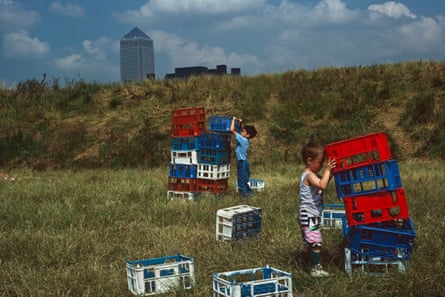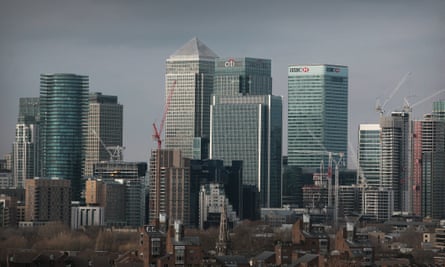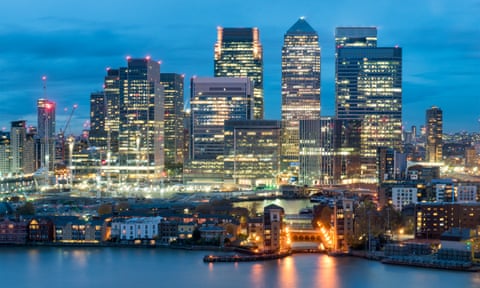The house I lived in, growing up on London’s Isle of Dogs, was beside a huge gate and high walls – impenetrable barriers even to the naughty kids who wanted to explore the docks beyond. My friends and I remember glimpses of watery wastelands as we walked off the Thames peninsula that we all called “the Island”, on rickety bridges whose gaps and creaks featured in our nightmares.
When, 30 years ago this month, Margaret Thatcher drove the first pile for Canary Wharf and promised a land of opportunity, those high walls came down. But by the time its celebrated pyramid roof was placed on One Canada Square in 1991, Thatcher had been ousted and the London commercial property market had collapsed. It was quite possibly the worst time to launch and, within a year, Olympia and York, the company charged with making the neoliberal dream of turning redundant docks into the reality of a gleaming financial citadel, filed for bankruptcy.
But now, Canary Wharf provides as many jobs as the docks did when they acted as a linchpin between the City of London and the global trade of the British empire. Canary Wharf’s first building, the second tallest in the UK after the Shard, is now as much a part of London’s skyline as the Empire State in New York and the area, with a further massive expansion already under way, is now more Wall Street than wasteland.
Yet the past three decades have not only tracked the boom and bust of the UK economy but have left the Isle of Dogs a microcosm of the social revolution that has changed the face of Britain. At the same time, the extremes of income inequality – from great wealth to desperate deprivation – have revealed social tensions that bedevil the country as a whole.
My mum and sisters still live on the island and I go back all the time; when the development first started, I had just gone to university and each holiday brought a new road network to negotiate and a new building site to discuss. I thought things could only get better for everyone living there, yet it took the surprise of Brexit to make me realise that the reality has been very different.
Local deprivation levels are among the worst in the country and a sense of powerlessness, which may have started as a reaction to the unaccountable regeneration scheme, now seems more widespread. The transport, shopping and leisure opportunities might have been revolutionised, but for a surprising number living there, Canary Wharf appears just as impenetrable as the docks were when I was a child.

Someone who remembers these times keenly is the Right Rev Nick Holtam, now the bishop of Salisbury. He was appointed to the local church in 1988 with an episcopal remit to try to improve community relations. Residents objected to the unelected nature of the London Docklands Development Corporation, the quango in charge of planning: there were marches and protests, one involving 60 dog-driven sheep and more than 150 bees.
Holtam remembers taking his congregation to a special service beside Millwall dock. “For lots of people, that was new territory, but there’s an invisible wall now, isn’t there?” he says. “People who live round the edge don’t all feel as though it’s their space to go into and it feels quite smart and City and businesslike.”
There have been enormous successes, of course, many of which were trumpeted in a special report commissioned by Canary Wharf to mark this year’s 30th anniversary. Canary Wharf Group has presided over the largest urban regeneration project in Europe, with more than 17m sq ft of London real estate providing the head offices for many global firms, from Barclays to Reuters. With 120,000 jobs, Canary Wharf claims to be the biggest single centre of employment in the UK.
In the early 1980s, unemployment had risen to 24% after the loss of thousands of jobs from the docks. While it was initially loathed by the hidebound denizens of the City, many financiers now believe that Canary Wharf, with its tax concessions and space enough for the large, open trading floors, saved London’s financial services industry and therefore the UK economy.
The change in the transport system has been even more remarkable. Young people at my old school on the island look at me like some sort of relic when I tell them that a 277 bus was the only form of public transport in the 1980s. It could take as little as 15 minutes or three times as long to get to my Saturday jobs in Poplar because of the way the bridge system played havoc on the roads. When the Docklands Light Railway was opened in 1987, everyone scoffed at its toy train driverless cars but, with a network that extends to Stratford and Woolwich in the east and Bank and Tower Gateway in the west, some 122 million people use it every year. Throw in, too, the underground lines: the Jubilee line opened in 1999 and, by the end of this year, a new east-west Elizabeth line station will be in place at Canary Wharf.
Looking back, the regeneration was a help to me personally. I was the first in my family to go to university and during college holidays I got lucrative work as a temp in some of the office buildings sprouting up. Yet for many residents, such employment has been harder to come by. Now, just one-tenth of the people working in Canary Wharf are residents of the borough, Tower Hamlets.

The larger companies moving in, such as Citibank and HSBC, may have taken advantage of the big business rate concessions, but they have tended to bring their staff with them. Jill Skeels has lived on the island for 48 years and describes the difficulties her daughter faced trying to get a local job. “I walked round the whole of Canary Wharf with my daughter, giving out CVs … never heard another word. So imagine how we feel. When you think of all what we’ve put up with and our kids can’t even get anything. I don’t think you’re bitter, I don’t think that’s the right word, but you just feel walked over.”
Years ago, talking to students from my old school about becoming a journalist, I remember one teenager saying she wanted to work in an office but couldn’t imagine getting a job in Canary Wharf. At the time, I think I brushed it off as one 14-year-old’s lack of confidence but it stuck with me and now I realise she wasn’t alone.
Time and again, talking to people in bingo halls or community associations, it’s the older white generation who are angriest about the changes. Rich Gerrard is an ex-docker: “The people in this area feel that no matter what they do, it’s a plan that they ain’t part of,” he says. “We are in the path of a runaway train.”
Howard Dawber, who has been managing director of strategy at the Canary Wharf Group since 2004, says much of the early anger was from people such as Gerrard who “wanted the docks back”. Very few middle-aged dockers got jobs in Canary Wharf, though one, Peter Wade, was appointed as the development’s first community development officer in 1988. He became a local cause celebre, a “poacher turned gamekeeper”.
The Canary Wharf Group, which has gone through several changes of ownership and now belongs to the Qatari state investment authority and global property company Brookfield, has spent millions investing in community projects or offering in-kind help such as mentoring for schools.
Insiders say the biggest barrier to those wanting a job in Canary Wharf is education. There is one 11-18 school on the Isle of Dogs, George Green comprehensive, my old school. When I left to go to the local authority sixth form college at 16 – not enough of us warranted the school running a sixth form – I was one of only two students to pass my maths exam at the first attempt. Yet, pre-league tables, I can’t remember anyone but the handful of us who wanted to do A-levels really making much of a fuss.

Far smaller when I was there, the school prided itself on an informal approach – no uniform and often chaotic classes. One friend of mine, an undiagnosed dyslexic, remembers skipping classes to take the books home to learn the biology syllabus. It was a tough school in some ways, with discipline often an issue, but there were, as there are now, some brilliant, dedicated teachers. Now there is a far more systematic approach and a relatively new head, Jill Baker, who has introduced tougher disciplinary measures.
An ugly, grey, breeze-block building in a fantastic location near Island Gardens, looking out towards Greenwich, the school also now has a thriving sixth form, largely filled with the children of immigrant families. Its results are now better than the national average: 40% of pupils achieved grade 5 or above in the new GCSE exams in English and maths, compared with 39.6% nationwide. What’s more, these figures don’t account for the high deprivation levels of kids who are already significantly underachieving at 11; the school scores highly for “adding value” by the time they leave.
An astonishing 76% of George Green’s pupils qualify for free school meals – far higher than the national average of 30% despite being two bus stops away from London’s financial capital. With just 20% of its pupils “white British”, compared with the vast majority when I was at school, English is a second language for two-thirds of its pupils. Around 5% have special educational needs and the school has had to lose support staff because of budget cuts in recent years.
Given these demands, it is little surprise that the teachers are grateful for any philanthropic support they can get from Canary Wharf and others. Ian Cullenbrooke, the assistant head, says trips and careers advice would be pretty much impossible without it.
It is true that several George Green pupils have benefited from mentoring programmes run by firms in Canary Wharf and even impressive internships, all of which would be far harder to get outside London. Talks from local high-flying employees are popular, but the teachers recognise that while many pupils say they want to be a banker/lawyer/journalist, far fewer of them have a realistic idea of how to get there from where they now are. There are, though, still norm-defying academic success stories.
Wafa Mohbubul is the school’s 17-year-old head girl and hopes to apply to read natural sciences at Cambridge. With 12 GCSE passes and a regular job looking after the elderly, she is currently deciding between a summer internship at Citibank or Morgan Stanley in Canary Wharf. The height of my Saturday job success was working for Marks & Spencer in Marble Arch, which meant leaving the island very early in the morning to get there on time.
As in the country as a whole, the biggest underachievers tend to be the white working classes. The reasons are many and complicated and Cullenbrooke, who recently taught in a comprehensive in Dagenham, saw the same trend there.

Recognising that there are exceptions to any rule, he says: “Students who come from immigrant families tend to be more aspirational. You know their families have come here more recently. They’re looking for opportunity and you know they’re trying to move on and to try to achieve as highly as they can. I think that with the ‘indigenous’ communities possibly you find more entrenched levels of low aspiration.”
Of all the changes on the Isle of Dogs over the past 30 years, housing is the most extreme and the thing most likely to cause a sense of despair. Once an area with the highest concentration of council houses in England, it is now one of the top 10 locations for foreign investors looking to buy London property.
When I was a child 95% of residents, my family and myself included, lived in council houses. That percentage has fallen dramatically. Right to buy, which allowed council tenants to buy their homes at preferential rates, had a huge effect. The island is not alone in this: in 1981, 82% of all homes in Tower Hamlets belonged to the council; just 12% did 30 years later. Like so much of London and the rest of the UK, in its place have come many more privately owned and rented properties.
The difference is in the extremes: estate agent Knight Frank found that a majority of Canary Wharf tenants are from overseas and the area can still feel a bit empty at weekends. By contrast, the busiest part is still the ring of largely substandard housing sandwiched between the river and the docks, the road I used to live on.
Fourteen-year-old Josh Holmes is angry about aspects of life on the island and many of the changes. He lives with his grandparents, single mum, aunt, uncle and two young cousins in a three-bedroom house near the school. “Looking at the current housing state, what they’re doing is building for the rich. They should be affordable,” he tells me. “Looking at these houses they’re building down the road from here, I’m not going to be able to afford them. My aunt’s not going to be able to afford them.”
The failure of the authorities to provide housing for the children of council tenants has long prompted bitterness, with complaints going back decades. Rich Gerrard sums it up: “In a way, the London Docklands Development Corporation was set up basically as a bunch of estate agents, so their major concern about people and communities isn’t inbuilt into their structure [as it would be with] a local authority.”

Photograph: Martin Godwin/The Guardian
Again, high-achieving Wafa is highly unusual in liking her council accommodation. She was moved, with her parents and three younger siblings, to a four-bedroom high-rise after their last flat caught fire. “We were emergency rehomed – it was life-changing because now I see the island differently,” she says. “I love it now.”
She has a view of the river from her bedroom and neighbours who include homeowners in the penthouse flats: “You’ve got many contacts, so if you’re from a very low-income family, you’ve got your neighbour who’s from a very high-income family and you can just relate and increase your network.”
Howard Dawber suggests that planners are now recognising the downsides of housing policies, which, though incredibly lucrative for many, have failed to provide a big enough mix, a failure to “create the steps for people moving out of social housing into low-priced, reasonable private accommodation. We as a society need to look at that gap in the market”.
Canary Wharf is doing just that, with 30 high-rise buildings planned at Wood Wharf in an eastern extension set to almost double the number of people living and working in the area within the next 10 years. Dawber hopes that the proposed mix of social housing, a school and GP surgery will build a sense of community – the word that time and again is used to talk about the issues that have haunted Canary Wharf. Property developers have to commit to 35% social housing to get more or less automatic planning permission and Wood Wharf is expected to meet that target by putting low-income residents in separate blocks.
Newfoundland, a high-rise currently being built with stunning views west across the Thames, for example, will have 700 new flats to rent with a gym and concierge on site. The 300-plus social tenants will be in separate lower-rise buildings in Poplar. This is to provide low-rise housing for families and to avoid the “poor back door” of some developments, but it still suggests a kind of segregation.
Wood Wharf, set for completion in 2023, is a further sign of the relentless pace of change on the island. But I have rarely known a time when the skyline wasn’t filled with cranes.
One woman I interviewed who works in the Canary Wharf Waitrose but refused to give her full name wants to move out of the area, partly because of the nonstop building work. She used to work in several pubs, but all were closed down and turned into lucrative private housing, she says.
Local objections have stymied some new plans, however, including proposals to build 2,000 homes in 33-storey towers, plans that would have meant the loss of a garage and, more importantly, encroachment on to the Mudchute, the island’s biggest – indeed, only – large area of green space.
The Mudchute, created by conveying silt and slurry from the creation of Millwall docks was one of the places I loved most growing up and residents obviously still feel the same way. People started to keep animals and grow food on the Mudchute when Canary Wharf was still a disused warehouse named after the islands that produced its fruit and vegetable cargo.
A 32-acre green space was the site of a sort of riding school and some weirdly generous scheme allowed me and a handful of horse-mad girls to skip PE once a week and learn to ride. I was so proud of the subsequent certificate in secondary education in horse mastership that I kept it on my CV for years. It was also helpful when I found myself studying at Cambridge, in proving I had “posh” habits.
The ramshackle place of my youth is a now a fully certified equestrian centre with prices to match. Yet entrance to the farm and fields is still free, partly financed by a highly successful nursery that offers wraparound care.
The fight to call a halt to high-rise development, to say “enough” to any encroachment on this incredible green space and example of community spirit – founded in the 1970s and still going strong today – feels somehow in the same spirit as all that talk of trying to get the balance between life and work right in Wood Wharf. Vicky Strong, assistant director of the Mudchute, doesn’t live on the island, yet she understands local concerns: “When I look at Canary Wharf, I think it’s amazing – to have something so grand on your doorstep. I still feel it’s an exciting time for the Wharf, but I think it needs to stop now.”
Canary Wharf is amazing. Every time I use the DLR, I marvel at the access it provides, not just to the shops and towers but to Stratford and beyond. The new Elizabeth line will make the trip to Heathrow less than 40 minutes. Yet, while the development has brought jobs and prosperity to some, the fact that poverty and deprivation have increased for those living on the island is astonishing. It’s as though the shadows cast by these feats of engineering have left such dark spaces that nobody saw what was happening inside.
The Long Shadow of Canary Wharf, presented by Jane Martinson, will be broadcast on BBC Radio 4’s Archive on 4 on Saturday 21 April at 8pm
- On 19 April 2018 this article was amended to clarify that George Green school’s results are now above average.
